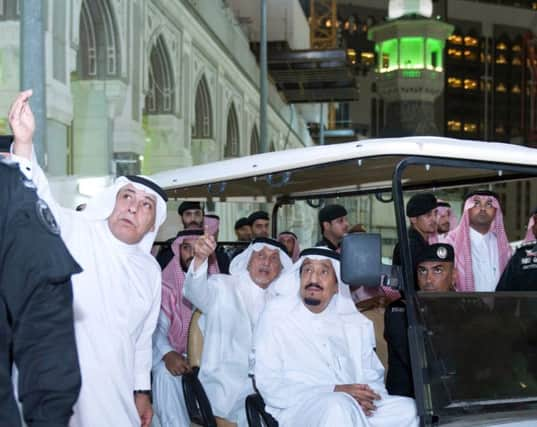Saudi king’s vow on Grand Mosque crane disaster


King Salman has also stated that the results of any investigation in the accident at Islam’s holiest site will be made public.
The hajj, a pillar of the Muslim religion that last year drew about 2 million faithful, will take place despite Friday’s tragedy, Saudi authorities said on Saturday as crowds returned to pray a day after the incident.
Advertisement
Hide AdAdvertisement
Hide AdHundreds of thousands of pilgrims had already arrived in Mecca when the massive red and white crane toppled over during a Friday thunderstorm.
“We will investigate all the reasons and afterwards declare the results to the citizens,” Salman said after visiting the site.
Parts of the Grand Mosque remained sealed off on Saturday around the wreckage of the crane, which also injured about 200 people when it crashed into a courtyard. Indonesians and Indians were among those killed when the crane collapsed, while the injured included Malaysians, Egyptians, Iranians, Turks, Afghans and Pakistanis.
Salman expressed his condolences to the families of the dead, and then visited a local hospital “to check on the health of the injured”, the official Saudi Press Agency said.
A Saudi official said the hajj, expected to start on 21 September, would go ahead despite the tragedy. “It definitely will not affect the hajj this season, and the affected part will probably be fixed in a few days,” said the official.
It is understood that the contractor, engaged in a major expansion of the mosque, has been ordered to check the safety of all other cranes at the site.
Condolences came in from around the Arab world, as well as from Britain, Canada, India and Nigeria.
It was not the first tragedy to strike Mecca pilgrims. In 2006, several hundred people died in a stampede during the Stoning of the Devil ritual in nearby Mina, following a similar incident two years earlier.
Advertisement
Hide AdAdvertisement
Hide AdIn the wake of the latest tragedy, the governor of the Mecca region, Prince Khalid al-Faisal, quickly called for the formation of a committee to investigate the cause of the accident.
Images posted by social media users showed police and onlookers attending to numerous bodies lying amid pools of blood on the mosque floors.
Saudi Arabia’s civil defence authority provided a series of rising casualty numbers on its official Twitter account as ambulances took the wounded to hospitals. A photo released by the authority showed police and workers in hard hats inspecting a pile of collapsed concrete slabs inside a part of the sprawling, ornately decorated mosque. Another showed the base of the toppled red-and-white crane tilted upward at a sharp angle.
Images aired on Saudi state television showed the crane’s metal boom smashed through what appeared to be the roof of the mosque.
Ahmed bin Mohammed al-Mansouri, the spokesman for the presidency of the Mecca and Medina mosque affairs, said that the accident happened during a severe storm carrying strong winds and heavy rain.
The Grand Mosque and the cube-shaped Kaaba within it draw Muslims of all types from around the world throughout the year, though numbers increase significantly in the run-up to the hajj.
Performing the pilgrimage once during one’s lifetime is a duty for all able-bodied adult Muslims.